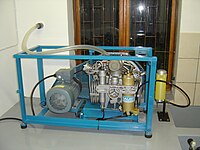
Photo from wikipedia
The main compressor in a supercritical carbon dioxide (SCO 2 ) Brayton cycle works near the critical point where the physical properties of CO 2 are far away from the… Click to show full abstract
The main compressor in a supercritical carbon dioxide (SCO 2 ) Brayton cycle works near the critical point where the physical properties of CO 2 are far away from the ideal gas. To investigate the effectiveness of the conventional one-dimensional (1D) loss models for predicting the performance of compressors working in such nontraditional conditions, detailed comparisons of 1D predicted performance, experimental data and three-dimensional CFD results are made. A 1D analysis method with enthalpy and total pressure based loss system is developed for multistage SCO 2 centrifugal compressors, and it is firstly validated against the experimental results of a single stage SCO 2 centrifugal compressor from the Sandia National Laboratory. A good agreement of pressure ratios with experiments can be achieved by the 1D method. But the efficiency deviations reveal the potential deficiencies of the parasitic loss models. On the basis of the validation, a two-stage SCO 2 centrifugal compressor is employed to do the evaluation. Three-dimensional CFD simulations are performed. Detailed comparisons are made between the CFD and the 1D results at different stations located in the compressor. The features of the deviations are analyzed in detail, as well as the reasons that might cause these deviations.
Journal Title: Journal of Thermal Science
Year Published: 2020
Link to full text (if available)
Share on Social Media: Sign Up to like & get
recommendations!